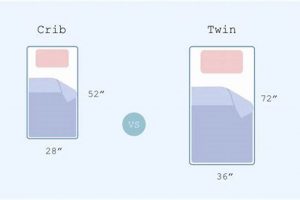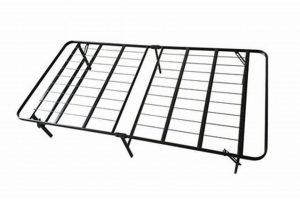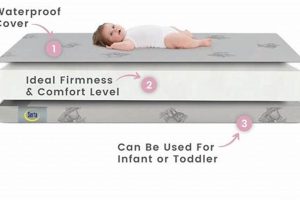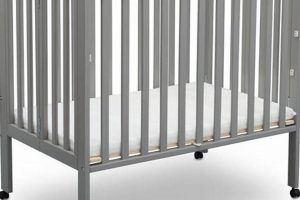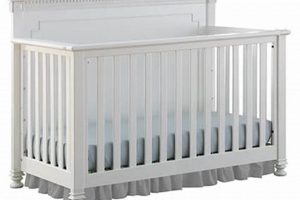The selection of a suitable sleep surface for infants is paramount to their health and well-being. This product, designed specifically for cribs, aims to provide optimal support and safety for a baby during crucial developmental stages. It is intended to be a firm, appropriately sized mattress that fits snugly within the crib frame, mitigating potential hazards.
The significance of an appropriate infant mattress lies in promoting restful sleep, which is vital for growth and cognitive development. Furthermore, the firmness of the surface is critical in reducing the risk of Sudden Infant Death Syndrome (SIDS). Historically, advancements in materials and manufacturing processes have led to increased safety standards and a wider range of available options designed to meet the evolving needs of infants and caregivers.
The subsequent discussion will delve into the various factors to consider when evaluating infant mattresses, including material composition, safety certifications, size and fit, and overall construction quality. This will provide a framework for informed decision-making when selecting a sleep surface that aligns with individual needs and priorities.
Essential Considerations for Selecting an Optimal Infant Mattress
The selection of a mattress for an infant crib requires careful consideration of several key factors to ensure safety, comfort, and proper support. These guidelines offer practical advice for evaluating available options and making an informed choice.
Tip 1: Prioritize Firmness. A firm surface is crucial for infant safety. The mattress should resist indentation when pressure is applied, minimizing the risk of suffocation and promoting safe sleep positioning.
Tip 2: Verify Size and Fit. The mattress must fit snugly within the crib frame, with no gaps exceeding two fingers in width. This prevents entrapment hazards.
Tip 3: Evaluate Material Composition. Consider the materials used in construction, prioritizing hypoallergenic and non-toxic options. Look for certifications such as CertiPUR-US, which indicates that the foam has been tested for harmful chemicals.
Tip 4: Check for Waterproofing. A waterproof or water-resistant surface is essential for hygiene and ease of cleaning. It protects the mattress core from spills and accidents.
Tip 5: Assess Weight and Durability. A balance between weight and durability is desirable. A lighter mattress is easier to change sheets, while a durable construction ensures longevity and continued support.
Tip 6: Review Safety Certifications. Ensure the mattress meets or exceeds current safety standards established by organizations such as the CPSC (Consumer Product Safety Commission).
Tip 7: Research Online Reviews and Ratings. Gather insights from other parents regarding their experiences with specific models and brands to inform decision-making.
Adhering to these guidelines ensures the selection of a mattress that provides a safe and supportive sleep environment for the infant, contributing to their overall health and well-being.
The following sections will address common concerns and questions related to infant mattresses, providing further clarity and assistance in navigating the available choices.
1. Firmness
The firmness of an infant mattress directly correlates with its safety and suitability. An excessively soft sleep surface presents a significant risk of suffocation, as an infant’s face can easily sink into the material, obstructing airways. Conversely, a sufficiently firm mattress resists indentation, maintaining a stable and safe sleeping position. The causal link between mattress firmness and infant safety is well-documented in pediatric health guidelines, emphasizing the importance of this attribute in reducing the incidence of Sudden Infant Death Syndrome (SIDS).
Selecting a mattress with appropriate firmness necessitates careful evaluation. The mattress should provide resistance when pressed upon, returning to its original shape without significant sinking. For example, a mattress that conforms excessively to the contours of an infant’s body may not provide adequate support, potentially leading to positional asphyxia. The practical significance of understanding the relationship between firmness and safety lies in enabling informed purchasing decisions. Caregivers must prioritize firmness over other considerations, such as plushness or comfort, when evaluating infant sleep surfaces.
In summary, mattress firmness is a critical determinant of infant sleep safety. Failure to prioritize firmness can have detrimental consequences. While other factors contribute to an ideal infant mattress, firmness remains paramount. A firm mattress aligns with established safety recommendations and provides a foundation for secure and restful sleep, mitigating risks associated with softer alternatives.
2. Safety Certifications
Safety certifications constitute a critical component in evaluating the suitability of a sleep surface intended for infant use. The presence of such certifications acts as an independent verification that the mattress has undergone rigorous testing and meets specific safety standards, thereby reducing potential hazards. A direct causal relationship exists between adherence to safety standards, as evidenced by certifications, and the mitigation of risks associated with infant sleep, such as Sudden Infant Death Syndrome (SIDS), suffocation, and exposure to harmful chemicals. Certifications like CertiPUR-US, GREENGUARD Gold, and those from the Juvenile Products Manufacturers Association (JPMA) provide assurance that the mattress has been tested for volatile organic compounds (VOCs), flammability, and structural integrity. The practical significance of understanding these certifications lies in the ability to discern products that genuinely prioritize infant safety from those that do not. For example, a mattress lacking a GREENGUARD Gold certification may emit VOCs that can negatively impact an infant’s respiratory health, highlighting the importance of this certification.
The implications of selecting a certified infant mattress extend beyond immediate safety concerns. Long-term health considerations are also addressed through these certifications, as they often encompass testing for allergens and other potentially harmful substances. Furthermore, these certifications typically require ongoing monitoring and compliance, ensuring that manufacturers maintain consistent quality control. In practical terms, choosing a mattress with multiple safety certifications offers a layered approach to risk reduction, providing a more comprehensive assurance of product safety. This proactive approach contrasts sharply with relying solely on marketing claims or unsubstantiated assurances, which lack the objective verification provided by independent testing agencies. Therefore, a thorough understanding of the different types of safety certifications and their respective criteria is essential for informed decision-making.
In summary, safety certifications serve as a crucial indicator of an infant mattress’s quality and safety. The challenges associated with evaluating infant sleep surfaces are mitigated by prioritizing mattresses that have undergone rigorous testing and verification processes. By recognizing the importance of these certifications and their specific criteria, caregivers can make informed decisions that contribute to a safer and healthier sleep environment for their infants. Linking this understanding to the broader theme of infant well-being underscores the significance of proactive safety measures in promoting healthy development and reducing potential risks.
3. Material Composition
The material composition of an infant mattress directly impacts safety, comfort, and durability, making it a critical consideration in the selection of a suitable sleep surface. Understanding the properties and potential risks associated with various materials is essential for making an informed decision.
- Foam Density and Type
Foam mattresses, often made of polyurethane or memory foam, vary significantly in density. Higher density foams generally offer better support and durability, but they can also retain more heat. Lower density foams are more breathable but may compress over time. The type of foam used also influences its performance; for example, plant-based foams may offer a more sustainable and less toxic alternative to traditional polyurethane.
- Innerspring Coil Count and Gauge
Innerspring mattresses rely on steel coils for support. A higher coil count generally indicates better support and contouring. The gauge of the steel, which measures its thickness, affects firmness and durability. Thicker gauge coils provide a firmer feel and greater resistance to compression. The arrangement and interconnection of the coils also contribute to the overall support and motion isolation properties of the mattress.
- Cover Fabric and Waterproofing
The cover fabric directly contacts the infant’s skin and influences breathability and moisture management. Common materials include cotton, organic cotton, and polyester blends. Waterproofing is crucial for preventing liquid penetration and maintaining hygiene. However, some waterproofing methods can reduce breathability. The ideal cover balances durability, breathability, and waterproof protection.
- Flame Retardants and Chemical Additives
Flame retardants are often added to mattresses to meet flammability standards. However, some flame retardants can be harmful to infants. Regulations have evolved to favor less toxic alternatives. It is essential to research the types of flame retardants used and prioritize mattresses that minimize or eliminate potentially harmful chemicals. Similarly, other chemical additives, such as antimicrobials, should be scrutinized for their safety profile.
The interplay of these material components determines the overall performance and safety of an infant mattress. By carefully evaluating each element and prioritizing non-toxic, durable, and supportive materials, caregivers can select a sleep surface that promotes a safe and healthy sleep environment for their infants.
4. Size and Fit
The dimensions and conformity of an infant mattress within a crib frame are paramount considerations in ensuring a safe sleep environment. Improper sizing can negate the intended safety features of a crib, potentially leading to hazardous situations.
- Standard Dimensions
Regulations stipulate specific dimensions for standard-sized cribs, typically around 28 inches wide by 52 inches long. A corresponding mattress must closely adhere to these measurements to prevent gaps along the crib sides or ends. Variances exceeding established tolerances create potential entrapment hazards for infants.
- Gap Prevention
The primary objective of proper sizing is to eliminate gaps between the mattress edge and the crib frame. These gaps pose a significant risk, as infants can become wedged in the space, leading to suffocation or other injuries. A fit test, involving manual inspection and measurement, is crucial to verify that no gap exceeds two finger widths.
- Mattress Thickness
While length and width are primary concerns, mattress thickness also plays a role in overall safety. An excessively thick mattress can reduce the height of the crib rails, potentially allowing an infant to climb out. Conversely, a mattress that is too thin may not provide adequate support or cushioning.
- Crib Compatibility
Not all cribs adhere precisely to standard dimensions. Some manufacturers may produce cribs with slightly different internal measurements. Therefore, it is imperative to verify the compatibility of the mattress with the specific crib model being used. Consulting manufacturer specifications and reviews can aid in this determination.
The relationship between mattress size and crib fit represents a critical element in infant sleep safety. Proper adherence to dimensional standards and vigilant gap prevention are essential to mitigate risks associated with entrapment and falls. The selection process must prioritize accurate measurements and compatibility verification to ensure a secure sleep environment.
5. Cleanability
The attribute of cleanability holds significant importance when evaluating sleep surfaces designed for infants. An infant’s environment is inherently prone to spills, regurgitation, and diaper leaks, necessitating a mattress surface that can be effectively and efficiently cleaned to maintain hygiene and prevent the growth of bacteria and mold.
- Waterproof or Water-Resistant Surface Materials
The presence of a waterproof or water-resistant barrier is paramount for simplifying the cleaning process. Materials such as vinyl, polyurethane laminates, or tightly woven synthetic fabrics prevent liquids from penetrating the mattress core. This reduces the risk of staining, odor retention, and the proliferation of microorganisms within the mattress. A mattress lacking this barrier requires more intensive cleaning efforts and may be more susceptible to irreversible damage and contamination. For example, organic spills that permeate the interior of a non-waterproofed mattress core become breeding grounds for harmful bacteria.
- Removable and Washable Covers
Mattresses featuring removable covers that can be machine washed offer a convenient and effective method for maintaining hygiene. Regular washing of the cover eliminates surface contaminants and allergens. The fabric’s durability and resistance to shrinking or fading after repeated washing cycles are important factors to consider. Zippers or secure closures should be robust to withstand frequent use. The absence of a removable, washable cover necessitates spot cleaning, which may not effectively remove all contaminants.
- Resistance to Staining and Odor Retention
The inherent properties of the mattress materials influence their resistance to staining and odor retention. Certain fabrics and foam types are more prone to absorbing liquids and odors than others. Materials with closed-cell structures or hydrophobic properties exhibit greater resistance to staining and odor accumulation. Surface treatments, such as antimicrobial coatings, can further inhibit bacterial growth and odor development. A mattress with high stain and odor resistance requires less frequent and less intensive cleaning, contributing to its longevity and hygiene.
- Ease of Spot Cleaning
Even with waterproof barriers and washable covers, spot cleaning is often necessary to address minor spills and accidents. The ease with which the mattress surface can be cleaned with mild detergents and water is a practical consideration. Surfaces that are smooth and non-porous facilitate easier cleaning compared to textured or porous materials. The ability to quickly and effectively remove stains and residues minimizes the risk of lingering contamination and odor.
These facets of cleanability collectively contribute to the suitability of a mattress for infant use. A sleep surface that incorporates these features simplifies maintenance, promotes hygiene, and reduces the risk of exposure to harmful microorganisms, aligning with the goals of selecting an optimal infant mattress. For instance, a mattress with a waterproof surface, removable washable cover, and stain-resistant materials provides a comprehensive solution for maintaining a clean and healthy sleep environment.
Frequently Asked Questions
The following section addresses common inquiries and concerns regarding infant sleep surfaces, offering clarification and guidance to assist in making informed purchasing decisions.
Question 1: What level of firmness is appropriate for an infant mattress?
An infant mattress must be sufficiently firm to reduce the risk of Sudden Infant Death Syndrome (SIDS). It should resist indentation when pressure is applied. A mattress that conforms excessively to an infant’s body is not recommended.
Question 2: What safety certifications should be prioritized when selecting a crib mattress?
Certifications such as CertiPUR-US, GREENGUARD Gold, and those from the Juvenile Products Manufacturers Association (JPMA) indicate that the mattress has undergone testing for harmful chemicals, flammability, and structural integrity. These certifications provide independent verification of safety standards compliance.
Question 3: What materials should be avoided in an infant mattress?
Materials containing phthalates, lead, and other toxic chemicals should be avoided. Mattresses with excessive flame retardants or known allergens are also not recommended. Researching the material composition and prioritizing non-toxic options is crucial.
Question 4: How frequently should an infant mattress be cleaned?
An infant mattress should be cleaned immediately following any spills or accidents. Regular cleaning of the surface and washing of removable covers helps to maintain hygiene and prevent the growth of bacteria and mold. Frequency depends on usage and potential soiling.
Question 5: What is the ideal thickness for a crib mattress?
While length and width are primary concerns, mattress thickness also influences safety. An excessively thick mattress can reduce crib rail height, posing a fall risk. A mattress that is too thin may not provide adequate support. Consult crib manufacturer guidelines for recommended mattress thickness.
Question 6: How important is the fit of the mattress within the crib frame?
A snug fit is critical to prevent gaps between the mattress and crib frame. Gaps pose an entrapment hazard. The mattress should be sized appropriately for the crib, with no gaps exceeding two fingers in width.
Selecting an appropriate infant mattress requires careful consideration of firmness, safety certifications, material composition, and fit. Prioritizing these factors contributes to a safer and healthier sleep environment.
The subsequent discussion will address emerging trends and innovations in infant mattress technology.
In Conclusion
The preceding discussion has explored the essential factors to consider when evaluating an infant sleep surface. From firmness and safety certifications to material composition, size, fit, and cleanability, a comprehensive understanding of these elements is crucial. The selection of an appropriate mattress directly impacts infant safety, health, and well-being, necessitating a diligent and informed approach. Prioritization of evidence-based guidelines and adherence to established safety standards are paramount in this process.
The decision regarding an infant’s sleep environment carries significant responsibility. Continued vigilance in monitoring emerging research, evolving safety standards, and advancements in mattress technology is encouraged. A proactive commitment to informed decision-making ensures a secure and supportive sleep environment, contributing to the optimal development of the infant.


